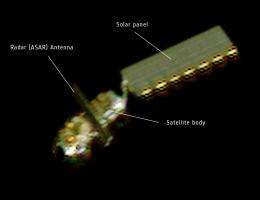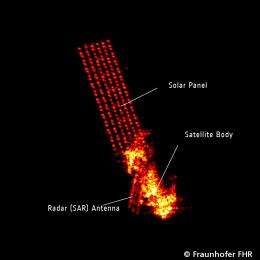Investigation on Envisat continues

(�鶹��Ժ) -- Optical, radar and laser observations of the Envisat satellite show that it is still in a stable orbit. Efforts to regain contact with the satellite have been under way since 8 April, when it unexpectedly stopped sending data to Earth.
To determine if Envisat has entered its ‘safe mode’ – which would be a starting point for revival – the recovery team is drawing on every information source available.
Valuable help is coming from many European and international partners. France’s new Pleiades satellite normally provides very high-resolution images of Earth, but is now focusing on Envisat to shed more light on the situation.
On 15 April, the French space agency CNES turned Pleiades to capture images of Envisat passing within about 100 km. This remarkable feat was possible thanks to the exceptional agility of Pleiades.
Flight specialists and engineers are using the images to determine the orientation of Envisat’s solar panel – the satellite’s power source.

If the panel is in a suitable position for sufficient exposure to the Sun, enough power is being generated to put Envisat into safe mode, and could allow for re-establishing communications with Earth.
“We are really grateful to CNES for offering to acquire images of Envisat using their Pleiades and Spot satellites,” said Volker Liebig, ESA’s Director of Earth Observation Programmes.
“Additional observations being acquired across the globe show how the international space community has come together to track this veteran satellite.”
The Fraunhofer Institute for High Frequency �鶹��Ժics and Radar Techniques in Wachtberg, Germany, is also providing images to help determine Envisat’s orientation.
Images from the TIRA ground-based tracking and imaging radar show the satellite’s body, solar panel and radar antenna.
“These unique images will enable us to analyse Envisat’s orientation, which will indicate whether we are able to regain contact with the satellite,” said Manfred Warhaut, Head of ESA’s Mission Operations Department.
Information on Envisat’s orbit is being provided by the US Joint Space Operations Center. In addition, multiple laser ranging stations on the ground are providing information to verify the stability of the satellite’s orbit.
The sudden interruption of Envisat services has disrupted data provision to the international Earth observation user community, which relies on data continuity.
The launch of the upcoming Sentinel series being developed for Europe’s Global Monitoring for Environment and Security (GMES) program has become even more urgent.
The Sentinels will provide the data needed for information services to improve the management of the environment, understand and mitigate the effects of climate change and ensure civil security.
Provided by European Space Agency





















